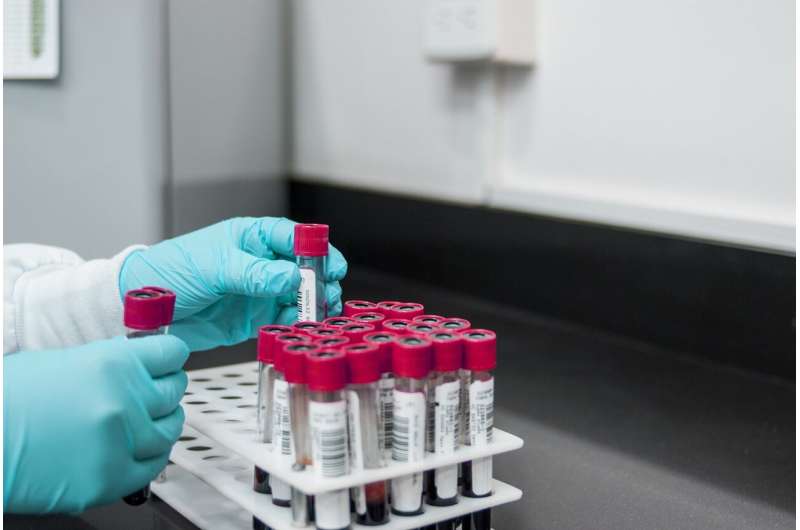This article has been reviewed according to Science X's editorial process and policies. Editors have highlighted the following attributes while ensuring the content's credibility:
fact-checked
peer-reviewed publication
trusted source
proofread
Study finds genetic screening of adults would be cost-effective

An exhaustive cost-benefit analysis of population genetic testing published in Annals of Internal Medicine concludes with a recommendation to U.S. health policymakers to adopt routine testing of adults ages 40 and under for three genetic conditions posing high risk of life-threatening illness.
For U.S. adults ages 20 to 60, the authors report age-based cost-effectiveness of hypothetical one-time, all-in-one screening for hereditary breast and ovarian cancer syndrome; Lynch syndrome, which is the most common cause of hereditary colorectal cancer; and familial hypercholesterolemia, which increases blood levels of low-density lipoprotein cholesterol and the likelihood of coronary heart disease and stroke at a younger age.
The three genetic conditions are designated by the U.S. Centers for Disease Control and Prevention as having the most evidence to support use of genetic testing for early detection and intervention. Testing for any of these conditions, when done at all, is currently limited to patients with a high-risk family history.
Screening adults of any age for genetic risk would be an historic step toward precision medicine, with a considerable price tag. The long-term benefits would be worth the cost, the study finds.
"Sequencing costs of genetic panels for these conditions have fallen to around $250, and our analysis shows the high up-front investment in genetic testing is gradually recouped with improved outcomes among people with genetic risks over their lifetimes," said a leader of the study, Josh Peterson, MD, MPH, professor of Biomedical Informatics and Medicine at Vanderbilt University Medical Center.
With some 1.5% of the U.S. population carrying these higher risks in their genes, current costs for screening everyone would outstrip any health care cost savings from improved disease prevention. In terms of total life years to be gained, in previous analyses of added costs posed by piecemeal population screening, the team found it would not be cost-effective for two of the conditions, with the third, hereditary breast and ovarian cancer syndrome, presenting a borderline case.
"The key lesson of the study is that we should be bundling genetic disorders into the same screening plan and testing individuals in advance while they are young adults and prior to any disease onset," said Peterson, director of the Center for Precision Medicine and vice president for Personalized Medicine at VUMC.
The quality-adjusted life year, or QALY, is a generic measure using both the quality and quantity of life gained to assess the value of medical interventions. Reflecting a common assumption in the literature, the new study defines interventions costing no more than $100,000-per-QALY as cost-effective in the U.S. context.
Based on costs for similar tests currently at market, the authors assumed a cost of $250 for a hypothetical all-in-one test limited to genes highly correlated with risk.
- The researchers found that, compared to usual care, screening 100,000 30-year-olds, for example, would result in 101 fewer overall cancer cases and 15 fewer cardiovascular events across their lifetimes.
- With a test costing $250—and, for positive results, a confirmation test costing another $250—one-time screening of 30- and 40-year-olds was cost-effective. In 30-year-olds, for example, at $33.9 million per 100,000 population, the added cost posed by screening and subsequent preventive care came to $68,600 per QALY gained. However, screening 50-year-olds with a $250 test was not cost-effective, due to missed opportunities to prevent disease in older populations.
- For 30-year-olds, the study found that screening would still be cost-effective if the test cost $413 or less.
- For 40-year-olds, the cost of a single test needed to be $290 or less, and for 50-year-olds, the cost would need to be $166 or less.
Beyond a focus on population genetics, disease risk and the cost of preventive interventions, the analysis accounts for a range of factors apt to enter into cost-effectiveness, from the probability that a positive test result would prompt testing by family members, to the likely uptake of risk-reducing interventions such as prophylactic surgery (and the impact of these interventions on quality of life).
More information: Josh Peterson et al, Population Genomic Screening for Three Common Hereditary Conditions: A Cost-Effectiveness Analysis, Annals of Internal Medicine (2023). www.acpjournals.org/doi/10.7326/M22-0846


















